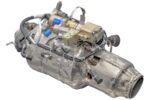The Royal Navy has begun deploying its Leonardo AW159 Wildcat helicopters armed with Thales’ Lightweight Multirole Missile (LMM), known as “Martlet,” in a counter-unmanned aerial system (C-UAS) role. This development marks a significant shift in the platform’s mission profile and reflects growing concerns over the proliferation of small drones in contested maritime environments.
Wildcat HMA2 Gains Air-to-Air Capability
The AW159 Wildcat HMA2 — already a key asset in the Royal Navy’s airborne surveillance and anti-surface warfare portfolio — is now being adapted to engage aerial threats. Traditionally equipped for anti-ship missions using Sea Venom missiles and Sting Ray torpedoes for anti-submarine warfare (ASW), the addition of the Martlet missile introduces an air-to-air dimension focused on drone interceptions.
The LMM Martlet is a lightweight precision-guided missile developed by Thales UK. Originally designed for surface and air launch against fast inshore attack craft (FIACs), it has proven adaptable against slow-moving or hovering UAVs. The missile weighs approximately 13 kg, has a range exceeding 6 km, and uses laser beam-riding guidance — making it suitable for engaging small targets with minimal collateral risk.
Operational Context: Littoral Threats and Drone Proliferation
This capability upgrade comes amid increasing use of drones by state and non-state actors in littoral zones — including reconnaissance quadcopters, loitering munitions, and swarming FPV drones. The Royal Navy’s Littoral Response Groups (LRG) operating near contested coastlines such as the Red Sea or Eastern Mediterranean are particularly exposed to these threats during amphibious operations or while escorting high-value assets.
According to recent Ministry of Defence briefings and open-source imagery from exercises such as Joint Warrior and WADER23, Wildcats have been seen carrying multiple Martlets on bespoke five-round weapon carriers mounted on stub wings. These allow rapid engagement of multiple targets without returning to base — critical when defending ships or landing forces against drone swarms.
Martlet Missile Performance Against UAVs
While not originally designed as an anti-air weapon, trials conducted since late 2021 have demonstrated that the LMM can successfully engage Class I UAVs (under 150 kg) at ranges up to several kilometers. Its beam-riding guidance is less susceptible to jamming than GPS- or RF-guided systems — a key advantage when facing electronic warfare-equipped drones.
- Warhead: Dual-purpose blast-fragmentation warhead effective against both soft-skinned vehicles and light aircraft
- Range: Over 6 km from air launch platforms
- Guidance: Semi-active laser beam riding
- Speed: Subsonic (~Mach 1)
- Launcher: Five-round launcher pods integrated onto Wildcat stub wings
The missile’s low weight allows Wildcats to carry up to ten Martlets without compromising endurance or maneuverability — enabling persistent coverage over amphibious task groups or merchant convoys under threat from hostile UAVs.
Tactical Implications for Naval Air Power
The integration of C-UAS weapons onto rotary-wing platforms reflects broader NATO trends toward distributed air defense layers. While fixed-site systems like Sky Sabre or CAMM provide area defense ashore or afloat, helicopters like the Wildcat offer mobile point-defense coverage across dispersed maritime formations.
This flexibility is particularly valuable in grey zone scenarios where attribution is difficult but drone threats are real — such as Iranian drone harassment in the Gulf or Russian FPV-style attacks near Black Sea shipping lanes. By arming Wildcats with Martlets, commanders gain an organic airborne intercept option that doesn’t rely on scarce fighter jets or larger SAM systems.
LMM Export Interest and Future Upgrades
The success of Martlet integration aboard UK Wildcats could spur export interest from other navies operating similar helicopters — including South Korea (AW159), Philippines (AW159), Brazil (Super Lynx), and Malaysia (Super Lynx). Thales has also proposed variants of LMM optimized for ground-based SHORAD roles under its “Fury” family branding.
Future enhancements may include improved seeker heads for autonomous terminal homing, integration with AI-assisted targeting pods aboard helicopters, or networked kill chains using shipborne radar cuing via Link-16 datalinks. Additionally, pairing LMM-equipped Wildcats with passive RF detection gear could enable silent tracking of emissions-heavy UAVs prior to engagement.









